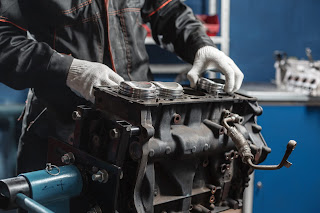For many drivers, the
engine compartment of a car is a mysterious place. So many moving parts and
gizmos and whatsits, it’s difficult to understand it. Have you ever sat and
wondered what makes engines so different? From a four-cylinder to a V6 and to a
V8, the difference is obvious. But, did you know that there are two different
types of four-cylinder engines? Toyota of Orlando has all of your questions answered and even a little crash course
on how engines work!
Toyota of Orlando’s engine crash course
The car engine is something many people
rarely think about unless they’re technicians or need car maintenance done. Although the inner workings are pretty
complicated, we’ve got a little crash course to get you on your way to being an
expert. Before we dive into what makes the boxer and inline engines different,
let’s dive into what makes a four-cylinder engine tick.
- 4-cylinder engines are “4 stroke” engines. This means that there are four different cycles that the engine must complete in order to generate power and motion.
- In the case of the Orlando Toyota four-cylinder engine, the four cycles are:
- Intake
- Power
- Compression
- Exhaust
- When a cylinder fires as the engine goes through the four cycles, it generates power. A cylinder will fire each time the crankshaft (a part that creates rotational motion to make the car move) rotates 180º.
- To operate, engines will generate “secondary forces” as a result of the engine cylinders moving or travelling. Efficient engines typically have additional equipment to not only counteract these forces but to use them for more power.
Four-cylinder and a world of differences
- Although both are four-cylinder engines, the boxer and the inline are different in their operation as well as their design. Specifically, the two are different in ways like:
- Boxer and inline Orlando Toyota engines move on a single plane, but their crankshaft placements are different. The boxer engine’s crankshaft is in the middle of the pistons and allows for greater stability due to counter secondary forces. The inline’s crankshaft is located on the end of the pistons and causes more vibration and less stability when driving.
- The two engines go through their stroke cycles in different orders. For the boxer, the cycle order is 1, 3, 2, and 4 and for the inline the order is 1, 3, 4, and 2.
- Although the boxer’s design may help with stability, it isn’t perfect. The engine tends to rock due to its larger shape. The inline’s engine keeps its vibration and shaking to a minimum because it has more of a straight line design.
- The Orlando Toyota boxer engine gives a much lower profile to vehicles that use it like the Toyota 86. These vehicles typically have low standing and wide front ends that create a unique rumble when driving.
- Inline engines are used mostly in production cars because of their simple design and ability to maximize space in the engine compartment.
- The boxer engine also causes an uneven flow of exhaust whereas the inline’s exhaust system is even and less noticeable.
Toyota of Orlando is here to answer your questions
Engines can get pretty
confusing and we at Toyota of Orlando are here to help! Give us a call at (407)
298 – 0001 or visit us at 3575 Vineland Road, just off I-4 near the Millenia
Mall.



No comments:
Post a Comment
Note: Only a member of this blog may post a comment.